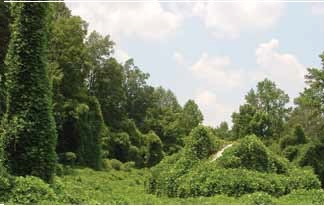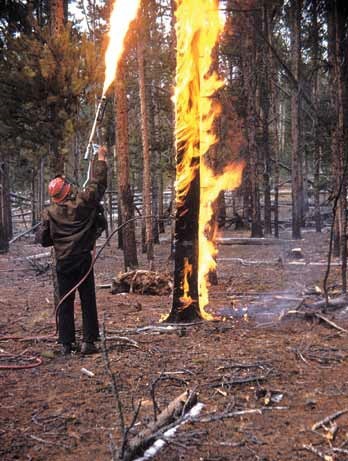 Adapted from PINEMAP publication NC AG-771 (2013), by H. Cole, M. Megalos and C. Temple.
Original article may be found at http://www.pinemap.org/publications/fact-sheets/Healthy_Forests_Invasive_Plants_and_Your_Forests.pdf
Adapted from PINEMAP publication NC AG-771 (2013), by H. Cole, M. Megalos and C. Temple.
Original article may be found at http://www.pinemap.org/publications/fact-sheets/Healthy_Forests_Invasive_Plants_and_Your_Forests.pdf
Invasive plants are referred to by many names: nonnative, exotic, nonindigenous, alien, or even noxious weeds. They come in all forms, including trees, shrubs, vines, grasses, and ferns. Invasive plants are aggressive survivalists and exhibit distinct adaptive strategies and characteristics:
- Grow vigorously
- Survive in a range of conditions
- Reproduce quickly
- Difficult to eradicate
Invasive Plant Concerns
Invasive plants reduce wildlife habitat diversity and quality even at low densities. Some increase wildfire risk and change soil chemistry. Invasive plant species also negatively impact forest productivity, biodiversity, ecosystem services, and potential use, currently costing $2 billion in economic losses each year in the United States alone.

Figure 1. A severe infestation of kudzu (Pueraria montana), a deciduous woody vine that grows densely along roads and in forests. Image courtesy of Kerry Briton, USDA Forest Service, Bugwood.org.
Planning Effective Management
When prevention fails, three main options remain: eradicate, control, and mitigate (see Table 1). Cost and other constraints can make eradication—total removal—difficult or impossible. Control and containment reduce long-term invasive plant density and population size to a manageable level. Mitigation lessens the impact of an invasion on other parts of the ecosystem, should it prove to be uncontrollable.
Table 1. Eradication, Control, and Mitigation Options
|
Benefits |
Drawbacks |
|
|
Eradicate |
|
|
|
Control and Contain |
|
|
|
Mitigate |
|
|
Prevention relies on extensive monitoring and proactive cleaning of all clothing and equipment to avoid spreading seeds. When using herbicide, select the chemical and application method best suited for the targeted invasive plant. Manually remove small, young populations by hand, or use mechanical equipment for large or established infestations.
Prescribed burning (see Figure 5) uses planned, low-density fires to control invasive populations. Water level manipulation can kill invasive plants susceptible to drought or submergence. Biological control uses pathogens from an invasive plant’s home range to control the target species. Prescribed grazing relies on cattle, sheep, goats, and horses to ingest edible, non-toxic invasives. Grazing typically rotates during spring and summer for multiple years and is used in conjunction with restoration methods. Mulching covers the soil surface with material to block an invasive plant’s access to light. Solarization uses a polyethylene sheet, usually black, to trap solar energy and heat the soil, killing low-growing, chopped, or mowed plants.

Figure 2. Prescribed burning is one way to control invasive
forest plants. Image courtesy of Chris Evans, Illinois Wildlife
Action Plan, Bugwood.org
Climate Impacts on Invasive Plants
Native species are more sensitive to abnormal weather or climate conditions, such as below-average summer precipitation, than invasives. Increasing winter temperatures will cause invasive plants to spread to higher elevations and northern latitudes. Also, increased atmospheric CO2 levels can disproportionately increase the growth rates, size, and seed production of invasive plants as compared to natives. Other climate-related impacts may also hinder proposed management actions and drive future infestations in unpredictable ways.
Chornesky, E. A., A.M. Bartuska, G.H. Aplet, K.O. Britton, J.C. Carlson, F.W. Davis, J. Eskow, et al. (2005). Science Priorities for Reducing the Threat of Invasive Species to Sustainable Forestry. BioScience, 55(4), 335-348. Retrieved from: http://naldc.nal.usda.gov/download/37746/PDF
Hellmann, J.J., J.E. Byers, B.G. Bierwagen, and J.S. Dukes. (2008). Five Potential Consequences of Climate Change for Invasive Species. Conservation Biology, 22(3). Retrieved from: http://blackbear.ecology.uga.edu/jebyers/PDF of papers/ Hellmann-et-al-Con-Bio-2008.pdf
Miller, J. H., S.T. Manning, and S.F. Enloe. (2010). A Management Guide for Invasive Plants in Southern Forests. Asheville, NC: U.S. Forest Service Southern Research Station. Retrieved from: www.srs.fs.usda.gov/pubs/36915
Weir, D., and J. Greis. (2011). The Southern Forest Futures Project: Summary Report. Retrieved from: http://www.srs.fs.usda. gov/futures/reports/draft/summary_report.pdf
Ziska, L. H. and K. George. (2004). Rising Carbon Dioxide and Invasive, Noxious Plants: Potential Threats and Consequences. World Resource Review, 16(4). Retrieved from: http://arsserv0. tamu.edu/SP2UserFiles/ad_hoc/12755100FullTextPublications pdf/Publications/ziska/potentialthreats.pdf
Miller et al. (above) provides more specific information on controlling invasive plants: www.srs.fs.usda.gov/pubs/36915
|
|
|
|
